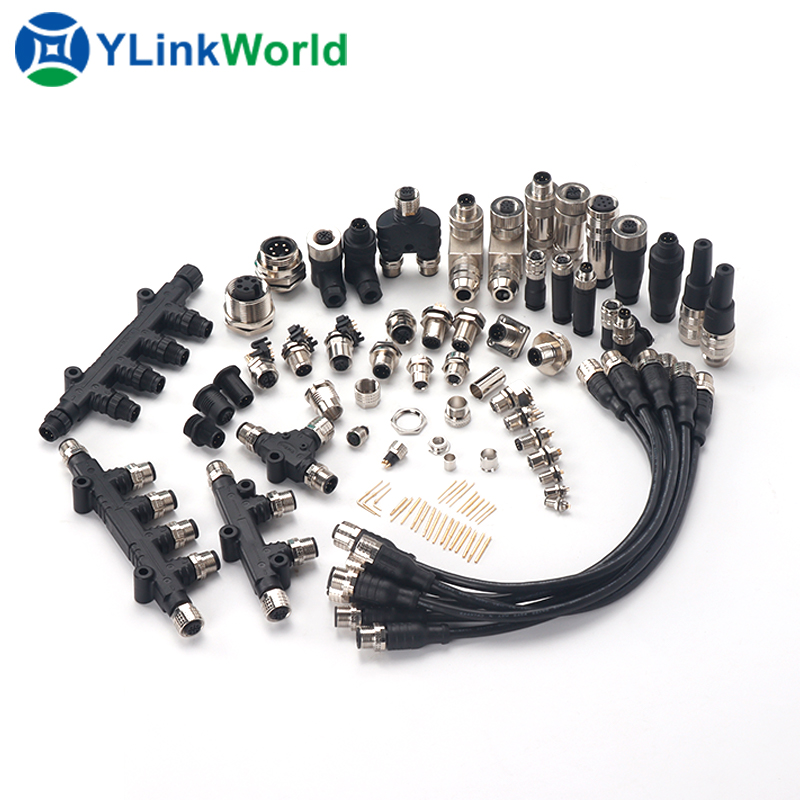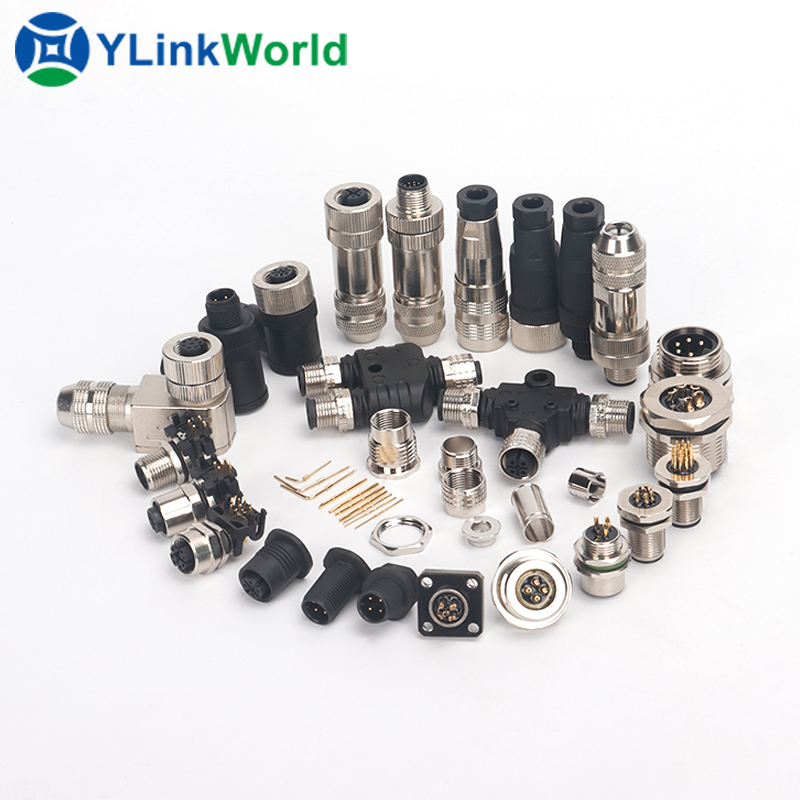1) M12 connector and M12 other connectors have little difference, are shell assembly, it is composed of a power plug, power socket, power plug shell assembly by the shell, lock sleeve, porn, nuts and other parts of the combination. After the lock sleeve and the shell are assembled, the nut is installed from the shell and riveted on the lock sleeve. The lock sleeve and the shell are set in the middle of the lock sleeve and can be rotated 20 degrees. The power plug shell is equipped with threads to connect the clamping effect.
After insertion, turn the lock sleeve support point to raise the steel ball to highlight the housing cavity and reach into the M12 strip connector on the power socket housing to clamp. It also has the advantages of anti-slant, anti-misinsertion, excellent electrical performance and shielding performance, shock resistance, impact resistance, natural environment, etc., clamping and opening save time and effort, small size and convenient application.
M12 Connector frequency
When the data information transfer rate is low, it is important to manage the method conductive deafness and the data signal kinetic energy spent on the M12 connector over long distances. When the higher mathematics ratio/high frequency transmission, the application of harmonic current high frequency can maintain the advantages of wave pattern square meters, but the potential scalar that harms the transmission quality creates a new problem for the whole selection process. For example, at 3GHz or higher, the electrolytic medium raw material that encapsulates the copper core electrical conductor is not only an insulating layer. It must also have the effect of maintaining the data signal as it is disseminated without loss.
To achieve this level, the electrolytic medium used is not only expensive, but also cannot be produced. The microwave heating material is generally selected with soft thermosetting polytetrafluoroethylene (PTFE), the material parameter is less than 2.0, coupled with the gas (the relative dielectric constant of the vacuum pump is 1), the electrical performance is improved, but the bending stiffness is reduced, resulting in the bending deformation of the cable used for aviation plugs under working pressure.
Attenuation coefficient and reflection
The attenuation coefficient and data signal reflection can be devastating to the high transmission data of the M12 connector. Plug loss applies to all cable components, and the main performance is reduced strength.
The sources of plug damage are electrical conductors, insulating material, data signal reflection inside the M12 connector/cable, and external open radiation sources, among which the cable is the most important.
The return loss is mainly due to mismatched characteristic impedances, and it also continues to create a standing wave problem, known as VSWR. In the worst case, the reflected wave corresponds to the incident wave, and the original phase difference is offset by 180°, that is, a simple standing wave with no signal basis.
Key reasons for VSWR in basic cable components. The jack between the male and female sides of the matching aviation plug is known to facilitate management. The real challenge is the jack between the M12 strip connector and the cable.
This is usually the reason behind the attenuation coefficient of the data signal in the cable components, and the extreme shift in performance between well-known brands. An effective M12 connector to cable connection method is particularly important in order to obtain improved VSWR performance cable equipment.
2) Since its introduction in 1985, the M12 connector has grown to become the interconnection system of choice in industrial automation. These robust connectors enable reliable connectivity in the harshest environments, revolutionizing connectivity in industrial automation.
The M12 connector is a circular connector with a 12 mm locking thread and generally has an IP protection class against liquid and solid intrusion. The M12 connector is ideal for sensors, actuators, and industrial Ethernet and fieldbus devices, primarily in industrial automation and corrosive environments.
Before the development of the M12 connector, engineers either pulled the wire directly, or had to repeatedly replace the connector due to poor service conditions. Originally released as 3 – and 4-pin models, the M12 connector was inferior to its predecessor, the RK30 connector, in terms of the maximum current allowed to flow, but it offered IP67 protection. The 4-pin M12 connector allows a single system to incorporate more advanced sensors and actuators. Today, these robust connectors are available in 3pin, 4pin, 5pin, 8pin,12pin, 17pin configurations, and new locking methods such as bayonet and push-pull are constantly being developed.
In addition to factory automation, M12 connectors and M12 cable assemblies can be used in measurement and control, communications, transportation, robotics, agriculture, and alternative energy. The right number of pins depends on the specific application needs – 3 and 4 pin models are used for sensor and power applications; 4 – and 8-pin models for Ethernet and PROFINET; DeviceNet and CANbus generally use 4-pin and 5-pin M12 connectors; 12-pin models are commonly used for a variety of signal applications.
In addition to the different pin counts, the M12 connector also utilizes multiple key codes to prevent mismatching. The following are the most common types of encodings and their uses:
l A code: sensor, DC, 1G Ethernet
l B code: PROFIBUS
l C code: alternating current
l D code: 100M Ethernet
l X code: 10G Ethernet
l S code: Alternating current (upcoming replacement of C-code power parts)
l T code: Direct current (soon to replace A code power parts)
The most popular M12 encoding types are A-encoding, B-encoding, D-encoding, and X-encoding. A-codes, B-codes, and X-codes are some of the earliest M12 connectors developed and longest on the market. In high-speed industrial Ethernet, X-coded connectors are in growing demand and will eventually replace A-coded and D-coded components in Ethernet applications. The latest M12 coding types currently under development are K for AC and L for PROFINET DC
1) M12 connector and M12 other connectors have little difference, are shell assembly, it is composed of a power plug, power socket, power plug shell assembly by the shell, lock sleeve, porn, nuts and other parts of the combination. After the lock sleeve and the shell are assembled, the nut is installed from the shell and riveted on the lock sleeve. The lock sleeve and the shell are set in the middle of the lock sleeve and can be rotated 20 degrees. The power plug shell is equipped with threads to connect the clamping effect.
After insertion, turn the lock sleeve support point to raise the steel ball to highlight the housing cavity and reach into the M12 strip connector on the power socket housing to clamp. It also has the advantages of anti-slant, anti-misinsertion, excellent electrical performance and shielding performance, shock resistance, impact resistance, natural environment, etc., clamping and opening save time and effort, small size and convenient application.
M12 Connector frequency
When the data information transfer rate is low, it is important to manage the method conductive deafness and the data signal kinetic energy spent on the M12 connector over long distances. When the higher mathematics ratio/high frequency transmission, the application of harmonic current high frequency can maintain the advantages of wave pattern square meters, but the potential scalar that harms the transmission quality creates a new problem for the whole selection process. For example, at 3GHz or higher, the electrolytic medium raw material that encapsulates the copper core electrical conductor is not only an insulating layer. It must also have the effect of maintaining the data signal as it is disseminated without loss.
To achieve this level, the electrolytic medium used is not only expensive, but also cannot be produced. The microwave heating material is generally selected with soft thermosetting polytetrafluoroethylene (PTFE), the material parameter is less than 2.0, coupled with the gas (the relative dielectric constant of the vacuum pump is 1), the electrical performance is improved, but the bending stiffness is reduced, resulting in the bending deformation of the cable used for aviation plugs under working pressure.
Attenuation coefficient and reflection
The attenuation coefficient and data signal reflection can be devastating to the high transmission data of the M12 connector. Plug loss applies to all cable components, and the main performance is reduced strength.
The sources of plug damage are electrical conductors, insulating material, data signal reflection inside the M12 connector/cable, and external open radiation sources, among which the cable is the most important.
The return loss is mainly due to mismatched characteristic impedances, and it also continues to create a standing wave problem, known as VSWR. In the worst case, the reflected wave corresponds to the incident wave, and the original phase difference is offset by 180°, that is, a simple standing wave with no signal basis.
Key reasons for VSWR in basic cable components. The jack between the male and female sides of the matching aviation plug is known to facilitate management. The real challenge is the jack between the M12 strip connector and the cable.
This is usually the reason behind the attenuation coefficient of the data signal in the cable components, and the extreme shift in performance between well-known brands. An effective M12 connector to cable connection method is particularly important in order to obtain improved VSWR performance cable equipment.
2) Since its introduction in 1985, the M12 connector has grown to become the interconnection system of choice in industrial automation. These robust connectors enable reliable connectivity in the harshest environments, revolutionizing connectivity in industrial automation.
The M12 connector is a circular connector with a 12 mm locking thread and generally has an IP protection class against liquid and solid intrusion. The M12 connector is ideal for sensors, actuators, and industrial Ethernet and fieldbus devices, primarily in industrial automation and corrosive environments.
Before the development of the M12 connector, engineers either pulled the wire directly, or had to repeatedly replace the connector due to poor service conditions. Originally released as 3 – and 4-pin models, the M12 connector was inferior to its predecessor, the RK30 connector, in terms of the maximum current allowed to flow, but it offered IP67 protection. The 4-pin M12 connector allows a single system to incorporate more advanced sensors and actuators. Today, these robust connectors are available in 3pin, 4pin, 5pin, 8pin,12pin, 17pin configurations, and new locking methods such as bayonet and push-pull are constantly being developed.
In addition to factory automation, M12 connectors and M12 cable assemblies can be used in measurement and control, communications, transportation, robotics, agriculture, and alternative energy. The right number of pins depends on the specific application needs – 3 and 4 pin models are used for sensor and power applications; 4 – and 8-pin models for Ethernet and PROFINET; DeviceNet and CANbus generally use 4-pin and 5-pin M12 connectors; 12-pin models are commonly used for a variety of signal applications.
In addition to the different pin counts, the M12 connector also utilizes multiple key codes to prevent mismatching. The following are the most common types of encodings and their uses:
l A code: sensor, DC, 1G Ethernet
l B code: PROFIBUS
l C code: alternating current
l D code: 100M Ethernet
l X code: 10G Ethernet
l S code: Alternating current (upcoming replacement of C-code power parts)
l T code: Direct current (soon to replace A code power parts)
The most popular M12 encoding types are A-encoding, B-encoding, D-encoding, and X-encoding. A-codes, B-codes, and X-codes are some of the earliest M12 connectors developed and longest on the market. In high-speed industrial Ethernet, X-coded connectors are in growing demand and will eventually replace A-coded and D-coded components in Ethernet applications. The latest M12 coding types currently under development are K for AC and L for PROFINET DC
Post time: Dec-04-2023


